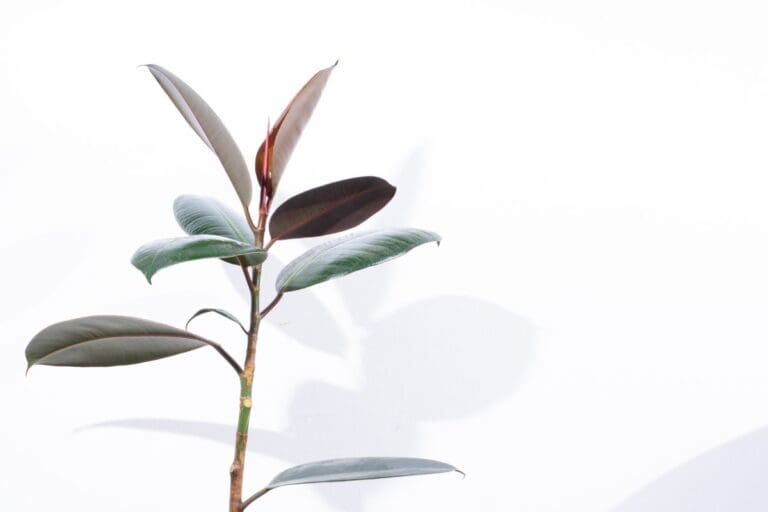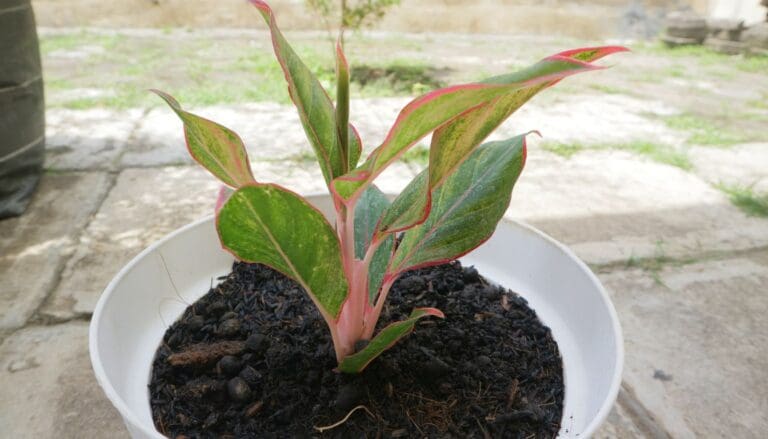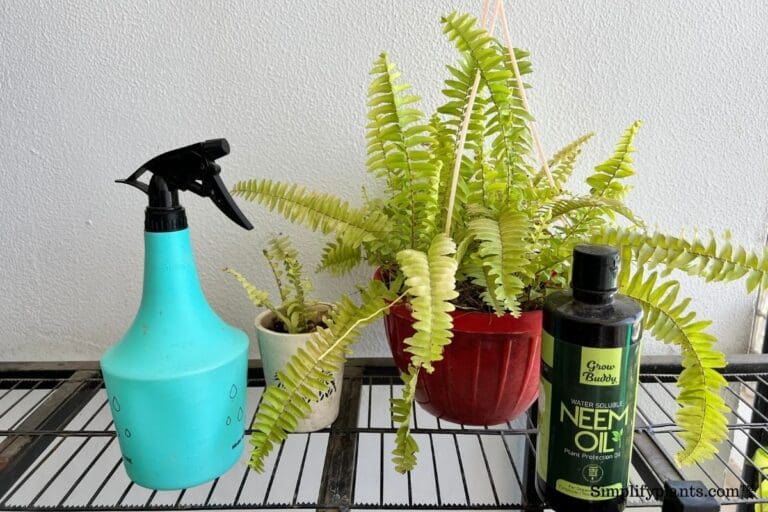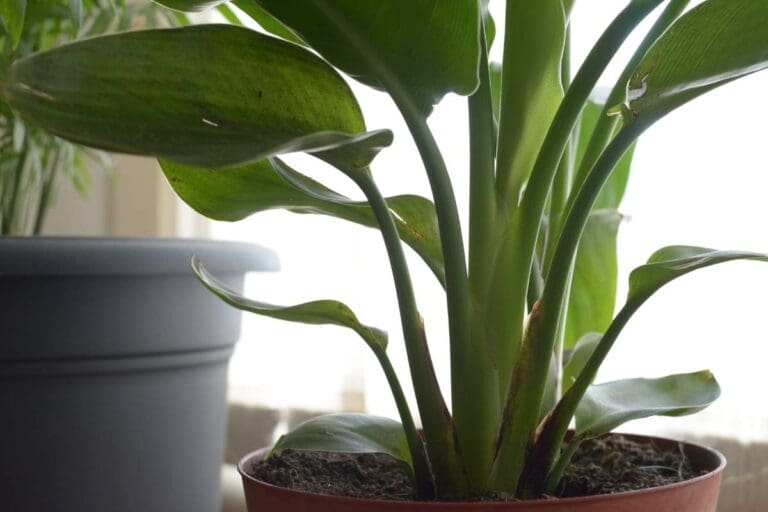Why Are My Chinese Evergreen Leaves Turning Yellow (Causes+Fix)
Chinese evergreen or Aglaonema is a tropical plant with a few different varieties of variegated and non-variegated leaves. But when these leaves turn yellow, it’s a clear indication that the plant is experiencing some problem.
In this article we shall learn why are your chinese evergreen leaves turning yellow and how can you save them.
Yellow leaves in Chinese evergreen is primarily due to improper watering, which leads to disbalance in soil moisture levels. Other reasons for yellow leaves in Chinese evergreen are low light, low humidity, and excess fertilizer. Provide adequate care to prevent further yellowing of leaves.
However, sometimes, the old leaves can get old and turn yellow before falling off, which is nothing to worry about.
This article will address all the reasons that lead to yellow leaves and how you can identify the one causing yellow leaves on your Chinese evergreen. Keep reading.

Please note: Simplify Plants is reader-supported. Some links in the post are affiliate links and I get a commission from purchases made through links in the post.
Why do Chinese evergreen leaves turn yellow?
One reason alone cannot cause yellow leaves on your Chinese evergreen, but there are a number of reasons to look at.
Understanding all these will help you understand what’s wrong with your plant and might help you prevent further problems as well.
Here is the list of reasons that cause yellow leaves in your Chinese evergreen:
- Overwatering
- Underwatering
- Low temperature
- Low light
- Low humidity
- Hot or cold drafts
- Repotting stress
- Pest infestation
- Diseases
- Fertilization issues
Now let’s dive into the details.
Overwatering

Chinese evergreen plants don’t need a lot of water. They need enough water to keep the soil evenly moist. But, a common misconception people have is watering more will make the plant grow more.
If you think the same, you’ll have an overwatered Chinese evergreen even before you know it. And an overwatered stressed Chinese evergreen gives out one of the first signs with yellow leaves.
Overwatering makes the soil waterlogged, and the excess water cuts out the oxygen supply, due to which the roots start suffocating. They fail to absorb moisture and nutrients from the soil, weakening the plant.
A weak plant can’t produce healthy green leaves, so yellow leaves appear.
If overwatering is the reason behind yellow leaves, you must stop watering immediately, keep the Chinese evergreen in a bright spot, and wait for the soil to get dry.
In severe conditions, you will need to take the plant out of the pot, get rid of the damaged roots, and repot it in a new pot with fresh soil mix.
Underwatering
Although Chinese evergreen doesn’t enjoy soggy soil, you can’t let the soil go bone dry. A Chinese evergreen requires water once a week during the growing season.
If you skip watering the plant for too long, it will get underwatered, and the soil will become dry and compact. The roots will not get any water, and the plant will dehydrate.
The leaves will not remain healthy with the lack of water and will turn yellow and crisp.
If you are forgetful about watering your Chinese evergreen, you can maintain a calendar that will remind you to water it. However, always water after checking the soil.
Also read: How Much Water Does A Chinese Evergreen Need? (How Often+Summer & Winter)
Low temperature
Tropical plants, such as Chinese evergreen, enjoy high temperatures similar to their natural habitat. They thrive at temperatures around 68-77°F.
However, if the temperatures start going low and below 55°F, Chinese evergreen will start having issues before it starts deteriorating. One sign of this is yellow leaves.
If you reside in a cold location, you must protect your Chinese evergreen from low temperatures. Also, you should keep your Chinese evergreen protected from the low temperatures during winter.
You must keep the plant away from frosty windows and not keep it outside during winter.
Also read: How Cold Can Chinese Evergreens Tolerate? (Chinese Evergreen Cold Tolerance)
Low light

Many people consider getting a Chinese evergreen because it can survive low light conditions. However, that is not the ideal condition for growing Chinese evergreen.
It will not photosynthesize as required if you don’t provide enough light. Due to poor photosynthesis, the leaves will start turning yellow.
If you have placed your Chinese evergreen in a dark spot, find a better spot with brighter conditions. A Chinese evergreen will do well with bright indirect light, but you can use artificial lights if you can’t provide enough natural light.
Also read: How Much Light Does A Chinese Evergreen Need? (Light Requirements)
Low humidity
Chinese evergreen prefers high humidity. In the tropical forests of Asia, these plants get a lot of humidity that helps them thrive.
The Chinese evergreen will do well with humidity around 60-70%. However, if the humidity level drops below 50%, you will notice problems. The leaves will lose all moisture and turn yellow and dry without humidity.
If your Chinese evergreen doesn’t get enough humidity, you can install a humidifier near the plant or group it with other moisture-loving plants to provide it with enough humidity.
You can even try misting your Chinese evergreen to add humidity to the plant. Don’t let the humidity go below 50% if you want to avoid yellow leaves due to low humidity on your Chinese evergreen.
Also read: Should I Mist My Chinese Evergreen? (+Humidity Guide)
Hot or cold drafts
Most houseplants, including Chinese evergreen, are sensitive to drafts. You should protect your Chinese evergreen from both hot and cold drafts.
Drafts cause temperature fluctuations that make the plant stressed and unhealthy. The leaves, therefore, become unhealthy and turn yellow.
You must protect your Chinese evergreen from drafts, keep it away from the direct air of the AC, and not keep it near any door or window that’s closed and opened frequently.
Repotting stress

The Chinese evergreen doesn’t require frequent repotting as it has a shallow root system and requires repotting once every 3-4 years.
However, every plant goes through some repotting stress as it is used to living in a particular situation and doesn’t prefer being shifted to a new pot with fresh potting mix.
So, if you notice yellow leaves right after repotting the Chinese evergreen, wait and give the plant some time. Take care of your plant and wait for it to recover the stress.
Once the plant recovers, you will notice healthy growth again.
Also read: When To Repot Chinese Evergreen? (Signs, Essential Supplies+How To)
Pest infestation
Did you know pests can cause yellow leaves? And keeping the Chinese evergreen under the wrong conditions will make it vulnerable and prey to pests.
Giving excess water to the Chinese evergreen will attract pests that enjoy moist conditions such as mealybugs, aphids, scales, etc. But if you keep your Chinese evergreen underwatered or do not provide enough humidity, pests like spider mites will infest the plant.
These pests feed on your plant, take all the nutrients out of it, making it weak and unhealthy. A plant that doesn’t get enough nutrients will not produce healthy leaves, and so you can come across yellow leaves if there’s a pest infestation.
If you don’t want pests on your Chinese evergreen, provide it with the ideal living conditions. Spray a neem oil solution once a month to keep the pests away.
If there is a pest infestation on your Chinese evergreen, you can use neem oil and spray it till you get rid of all the pests. This is an organic and safe way of removing pests.
Also read: Do Chinese Evergreen Get Bugs? (Common Bugs+How To Get Rid Of Them)
Diseases

Bacterial blight can also cause the leaves of your Chinese evergreen to turn yellow. This is a bacterial disease that is often found in many plants.
Bacterial blight occurs when you overwater your Chinese evergreen. The leaves start getting yellow and then develop black spots on the leaves.
If this is the case with your Chinese evergreen, you must isolate the plant and prune all the affected parts of the plant. Provide the plant with all the right conditions and help it return to health.
However, if the disease has spread across most parts of the plant and you find almost no healthy leaves, you will need to discard the plant and start with a new one.
If you want to avoid bacterial and fungal diseases on your Chinese evergreen, you must not overwater the plant.
Fertilization issues
Chinese evergreen doesn’t require a lot of fertilizer, but it requires feeding during the growing season. You can fertilize your Chinese evergreen once a month during spring and summer with a 10:10:10 fertilizer.
Now, what happens when you give it more than it needs? The plant gets overfertilized, which can be a reason behind the yellow leaves on your Chinese evergreen.
The plant gives out yellow leaves if you have overfertilized them for a considerable time. You might notice other signs, such as salt build-up on the soil.
If you don’t want to overfeed your Chinese evergreen, dilute the dose to make it half-strength and avoid fertilizing the plant during the winter season.
Even under-fertilization can cause yellow leaves on your Chinese evergreen. Although Chinese evergreen doesn’t require much feeding, you must not stop fertilizing it altogether.
If the plant doesn’t get sufficient Nitrogen, Phosphorus, or Potassium, it will develop yellow leaves. Therefore, you must fertilize it with a well-balanced fertilizer.
Not repotting the plant for too long can also cause yellow leaves. As the soil gets old, it loses all its nutrients and fails to absorb the nutrients you add as fertilizers, thus causing a nutrient deficiency in your plant.
You must repot the Chinese evergreen once in 3-4 years to avoid causing a nutrient deficiency in the plant.
Also read: Does Chinese Evergreen Plant Needs Fertilizer? (How Often+Best Fertilizer)
Old leaves

There are times when the leaves of your Chinese evergreen complete their lifecycle and turn yellow. It is a natural process, and you shouldn’t get worried if this happens.
If your plant is healthy and getting all the right living conditions, wait for the leaves to fall off the plant. Don’t panic, as every plant goes through this process before losing the yellow leaves.
How to prevent yellow leaves on your Chinese evergreen?
Providing the right growing conditions and paying attention to the plant can prevent the yellow leaves. Keep in mind these few points for keeping your Chinese evergreen healthy.
- Provide bright indirect light to your Chinese evergreen. If there’s a lack of natural light, use artificial lights.
- Water your Chinese evergreen when the top inches of the soil dry out. Reduce watering during the winter season if you don’t want to overwater the plant.
- Don’t let the soil go bone dry so water your Chinese evergreen enough to moisten the soil.
- Fertilize your Chinese evergreen with a diluted dose of fertilizer during the growing season. Avoid fertilizing in the winter as that is the dormant period.
- Spray a neem oil solution once a month on your Chinese evergreen to keep the pests away.
- Repot the Chinese evergreen when it gets rootbound or once in 3-4 years.
- Avoid exposing the Chinese evergreen to hot or cold drafts, frost, and temperature fluctuations.
- Keep the leaves of your Chinese evergreen clean to help it photosynthesize better.
- Use a humidifier or group your Chinese evergreen with other plants to increase the humidity around it.
- Rotate the Chinese evergreen every few days to ensure it gets light on all sides and grows evenly.
Should I cut yellow leaves off Chinese evergreen?
In rare cases, the yellow leaves turn back to green. Mostly, these leaves dry up and fall off the plant. So, you can wait for the leaves to fall off your Chinese evergreen or prune them with a sharp and sterilized pruner if you don’t like the sight.
Reference: Wikipedia, Nasa clean air study, Missouri Botanical Garden, The University of Kansas, NC State University.
Recommended Garden Supplies
| Product Image | Our Recommended Gardening Supplies | Check Offers! |
|---|---|---|
Top Top
Top
Top
Top
Top
Top
Top
Top | rePotme Houseplant and Tropical Classic Potting Soil Mix | Check Offer On Amazon |
 Top
Top
Top
Top
Top
Top
Top
Top | Espoma Organic Indoor Plant Food | Check Offer On Amazon |
 Top
Top
Top
Top
Top
Top
Top
Top | GooingTop LED Grow Light 6000K Full Spectrum Clip Plant Growing Lamp | Check Offer On Amazon |
 Top
Top
Top
Top
Top
Top
Top
Top | Soil Moisture Meter | Check Offer On Amazon |
 Top
Top
Top
Top
Top
Top
Top
Top | Govee Hygrometer Thermometer, Bluetooth Enabled! | Check Offer On Amazon |
 Top
Top | LEVOIT Humidifiers for Large Room(Best For Plants) | Check Offer On Amazon |
 Top
Top
Top
Top
Top
Top
Top
Top | Upgraded DIY Automatic Drip Irrigation Kit, 15 Potted Houseplants Support | Check Offer On Amazon |
 Top
Top
Top
Top
Top
Top
Top
Top | Stainless Steel Heavy Duty Gardening Tool Set | Check Offer On Amazon |
 Top
Top
Top
Top
Top
Top
Top
Top | Bonide Insecticidal Soap | Check Offer On Amazon |
 Top
Top
Top
Top
Top
Top
Top
Top | Bonide 32 oz Spray Neem Oil for Organic Gardening | Check Offer On Amazon |
 Top
Top
Top
Top
Top
Top
Top
Top | Garden Safe Fungicide | Check Offer On Amazon |






